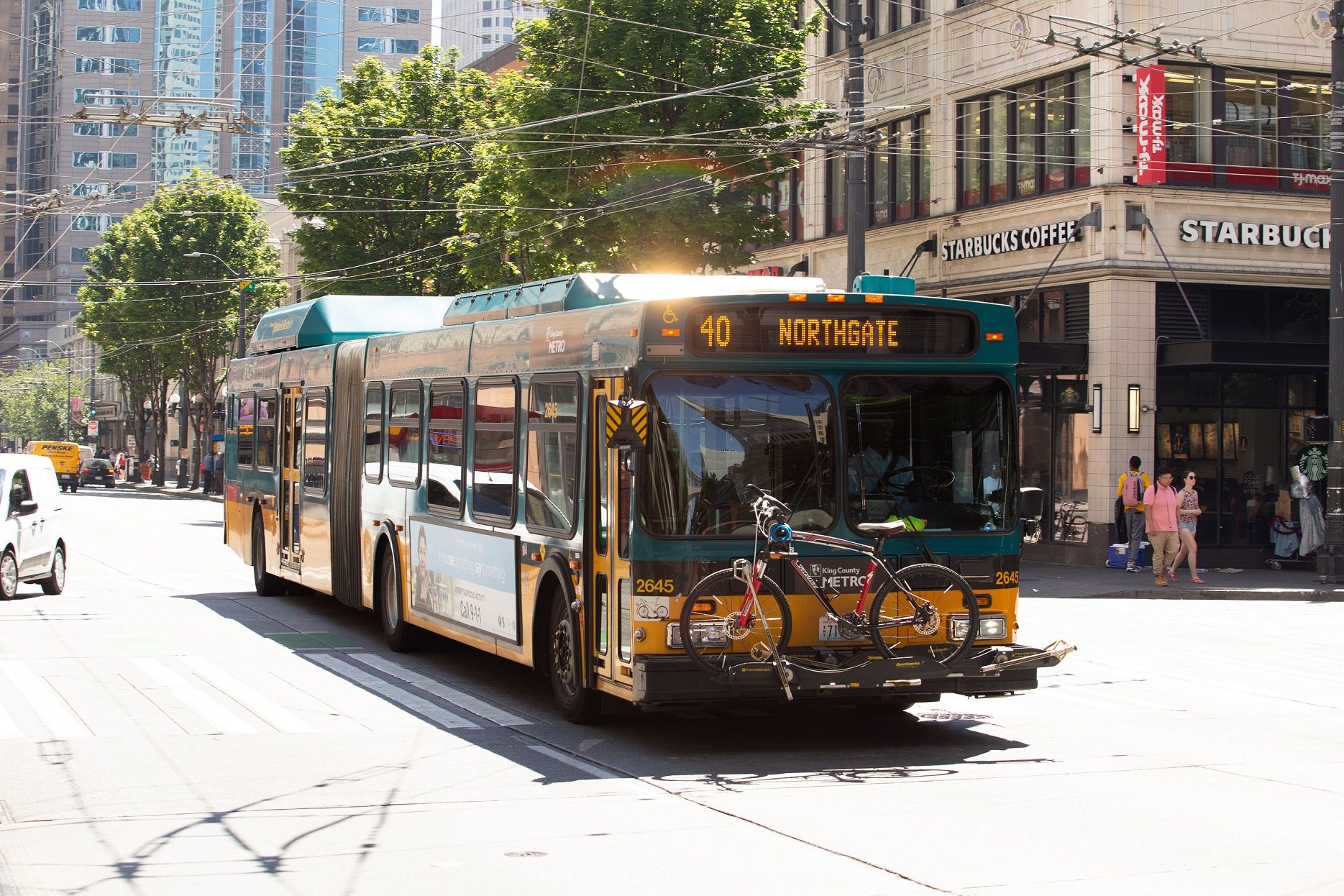 The King County Metro Route 40 bus in downtown. Photo credit: King County Metro
The King County Metro Route 40 bus in downtown. Photo credit: King County Metro Blog stats: 1,600 words | 8-minute read
We’ve completed final design on the Route 40 Transit-Plus Multimodal Corridor project with vital input from the community. This project will create a safer and more reliable bus route and Seattle’s first-ever freight- and bus-only lane. Since early 2020, we’ve engaged community members and bus riders to gather feedback on the Route 40 project design as it evolved.
The next step is advancing to the contractor selection process as we work to complete this important Levy to Move Seattle-funded project. Construction begins in 2024. Thanks to everyone who has provided their feedback!
At-a-glance:
- Read our outreach summary highlighting what we learned from bus riders and the community, and how we refined the design to address these interests
- Enjoy bus travel times up to 10% faster upon project completion
- Get to work, shopping, and home easier using better curb ramps, new traffic signals, and a new bike connection
- Learn about a new way we’re helping make freight trips more reliable and how loading zones will be managed
- Read about watermain and paving upgrades at key locations along the route
- Visit the project webpage for the complete final design plans
- Start thinking about how we can work with you during construction – what do we need to know?
The Route 40 project will provide several important benefits, including:
- 3 total miles of Business Access and Transit-only lanes and Freight and Bus-only lanes
- 5-10% transit travel time reductions
- 47 upgraded ADA-accessible curb ramps
- 8 new bus bulbs (for safer and more convenient boarding)
- 6,000+ feet of upgraded sidewalks
Project outreach and community engagement recap
We appreciate all the input that we have received from our project neighbors, local businesses, bus riders, and advocacy and advisory groups. You can learn more about our project outreach and engagement in our outreach activities report.
By the numbers:
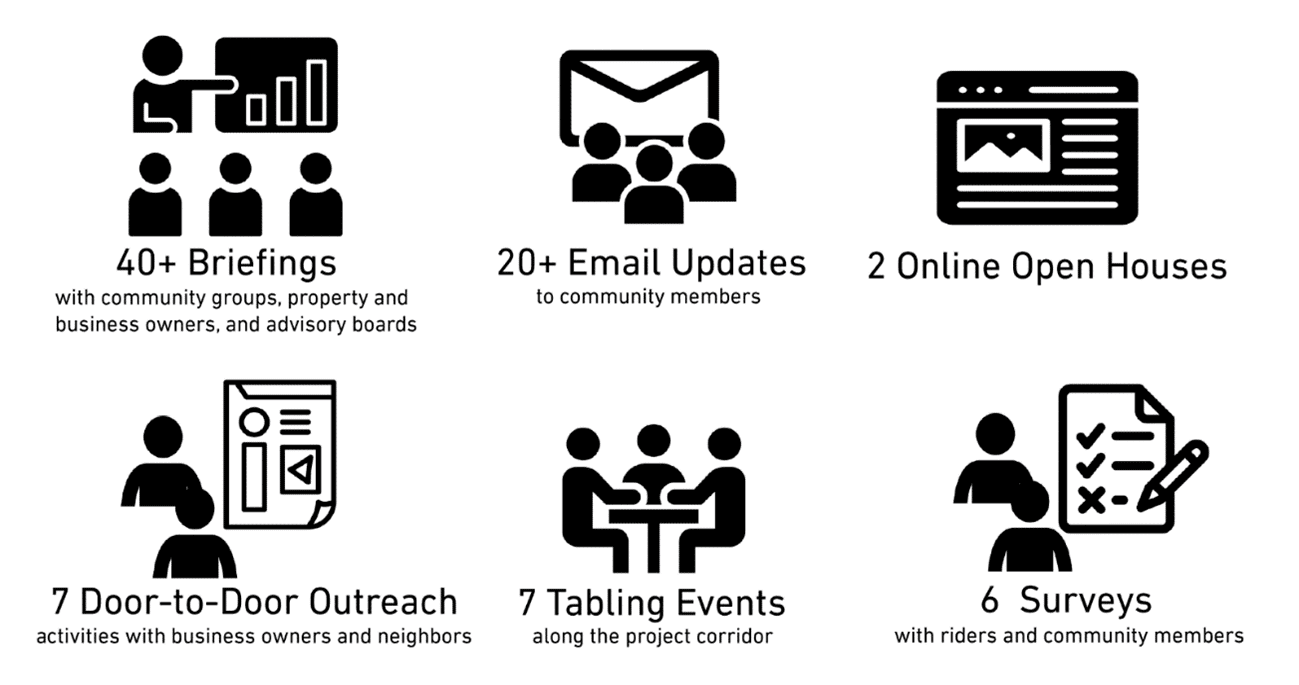
To learn more about what we heard from community members, please see our summer 2023 outreach summary or our fall 2023 outreach summary. You can also find some top themes listed below.
General themes of community priorities:
- Overall support for the design of the Route 40 corridor as it was developed.
- Overall support for increased traffic calming measures throughout the Route 40 corridor.
- Overall support for additional safety and mobility improvements for people walking, biking, and rolling.
Key community concerns about the design included:
- Concerns from Fremont business owners about personal and property safety near bus stops.
- Concerns from business owners about parking removal and changes to loading zones in the Westlake, Fremont, and Ballard neighborhoods.
- Concerns from business owners about freight movement in the Westlake neighborhood.
- Concerns from neighbors about increased traffic congestion in Fremont, Ballard, and Westlake.
- Questions from neighborhood organizations about what environmental review was completed for the project, specifically regarding vehicle emissions and water pollution.
In response, we updated the final design or responded by:
- Met with Fremont businesses, property owners, and King County Metro to discuss bus stop design and will continue to reach out on amenities.
- Maintained the total number of loading zones in each neighborhood and added new zones in Westlake and Fremont to support commercial loading for businesses and customers.
- Confirmed plans to launch a Freight and Bus-only Lane pilot project on Westlake Ave N. This pilot will allow freight trucks over 26,000 pounds (about the size of a garbage truck, large box truck, or semi-truck) to use select bus lanes, be in effect 24/7, and be evaluated by the Urban Freight Lab.
- Completed a traffic analysis during the early planning and design phase. Full details and results are available in a summary report. And committed to business and property owners to observe traffic patterns after project completion and keep them engaged on findings and their experience.
- Provided information on the environmental analysis in the State Environmental Policy Act (SEPA) process. The project received a Determination of Non-Significance in spring 2023. This determination confirmed that the project will not have a probable significant adverse impact on the environment. You can learn more by reading the SEPA documents.
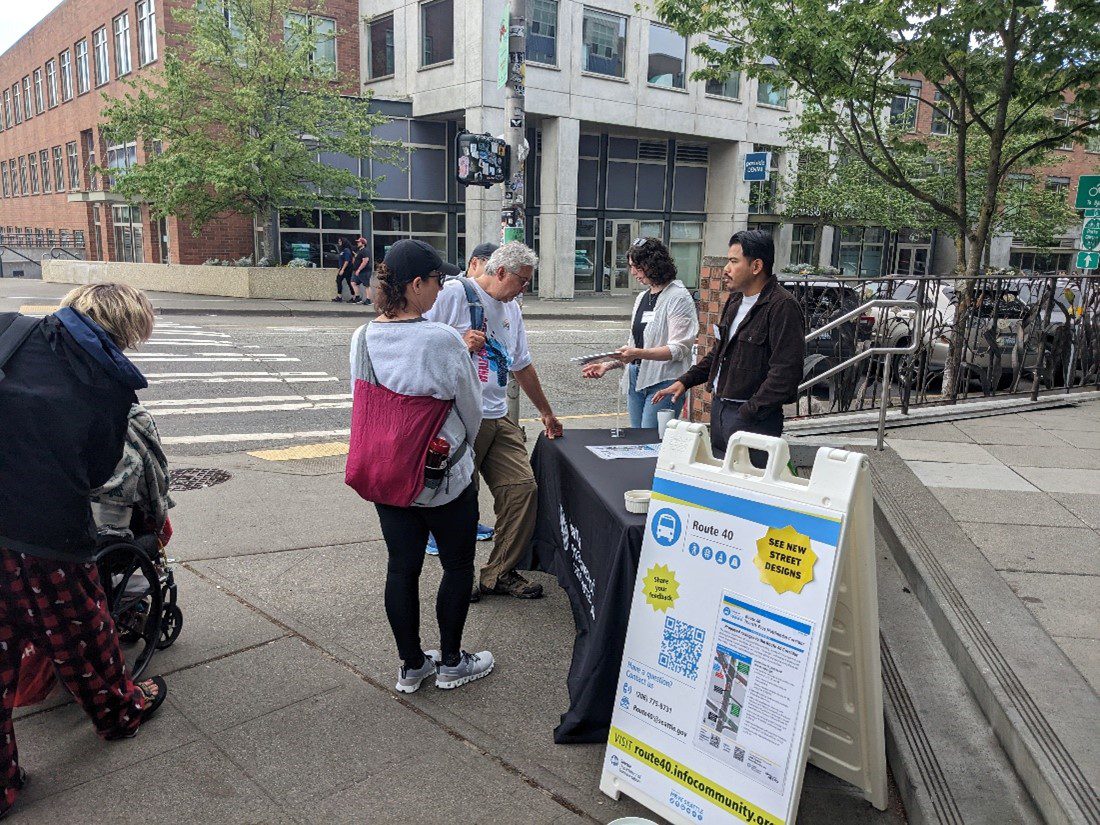
Route 40 continues to be an important route for our neighbors and we’ve heard their desire for neighborhood improvements for people who roll, walk, bike, and ride the bus.
Route 40 serves the Northgate, Crown Hill, Loyal Heights, Ballard, Fremont, South Lake Union, Downtown Seattle, and Pioneer Square neighborhoods. More than 95,000 people live within a half-mile of Route 40.
Ridership is continuing to increase as more people look for sustainable ways to get to where they need to go. As of August 2023, daily ridership on Route 40 totaled over 7,500 people on the average workday, showing that this route remains one of King County Metro’s highest ridership routes.
We’ve heard from neighbors and neighborhood groups just how important it is to make improvements to Route 40. We have a goal of reducing peak transit travel times by 5% to 10% and making the time between buses more consistent so trips take about the same amount of time, no matter the time of day.
The project improvements are focused in four key areas: Westlake, Fremont, Ballard, and North Seattle.
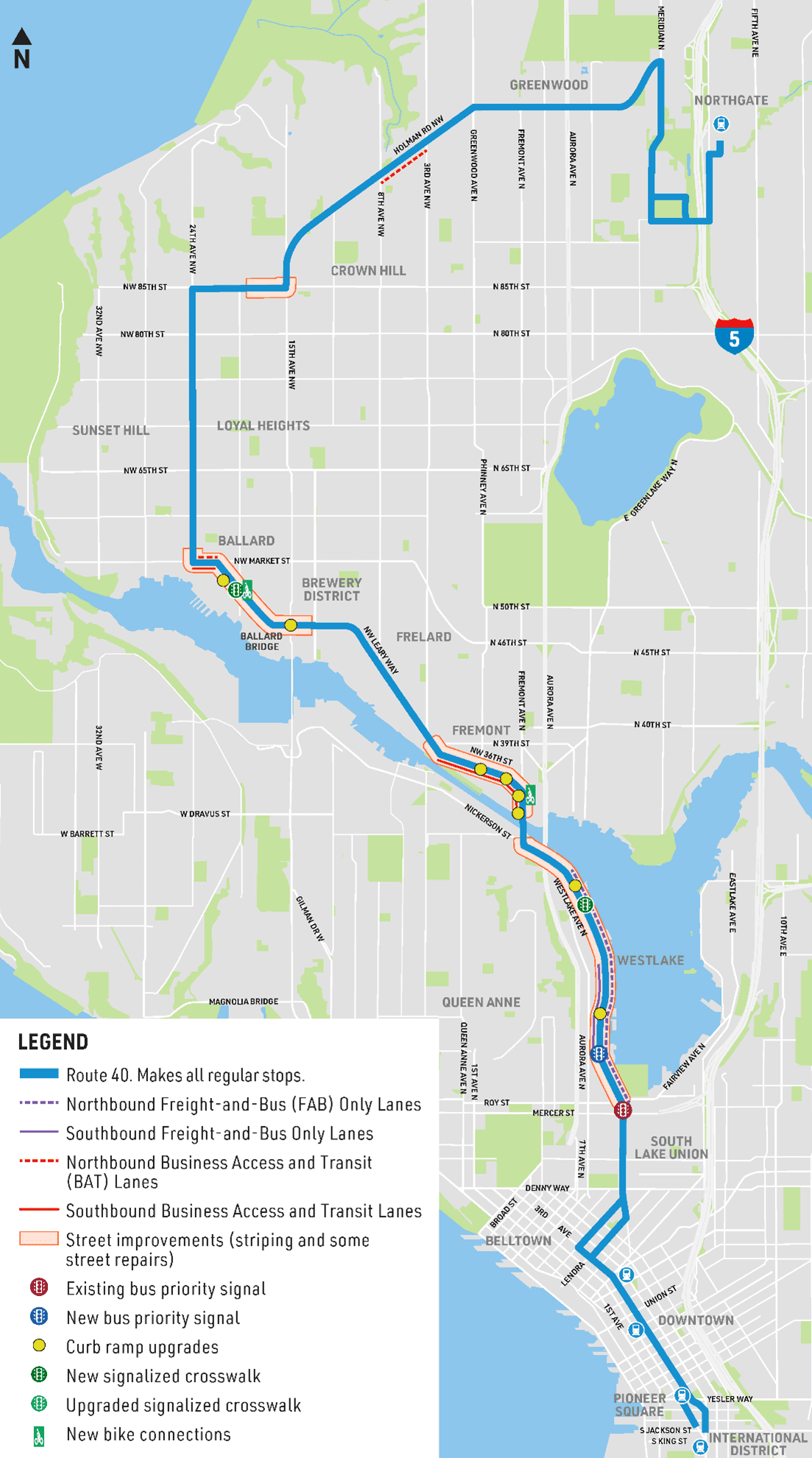
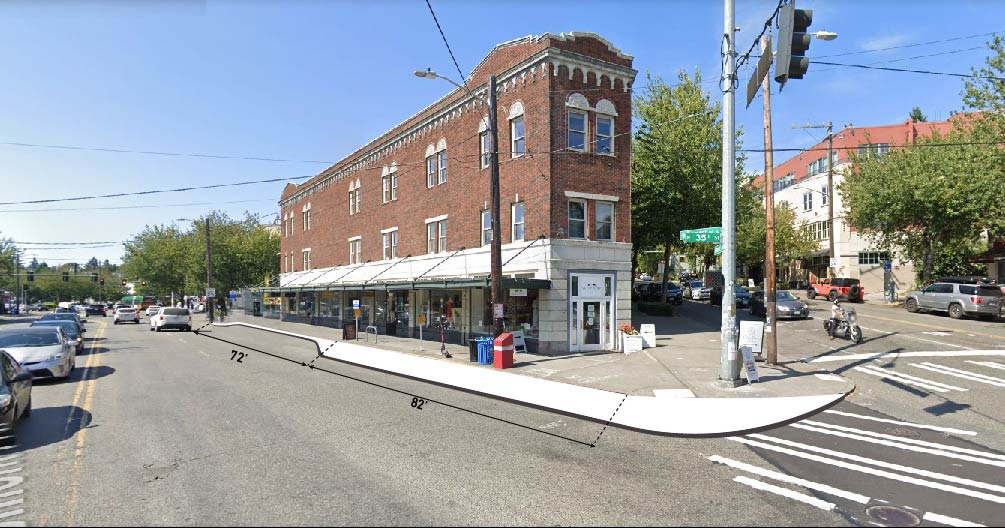
Supporting freight mobility and goods deliveries
To help keep freight moving along Westlake Ave N, a major truck street, we’re piloting new “Freight-and-Bus only” lanes. People driving large freight vehicles over 26,000 pounds (about the size of a garbage truck, large box truck, or semi-truck) can use these lanes.
These lanes will be piloted for one year. After the trial period ends, we will review data and input from freight drivers to help determine if they should be installed permanently along Westlake Ave N and potentially be added to our toolbox for other Seattle streets.
The project also includes implementing Businesses Access and Transit-only lanes in certain locations (see map graphic above).
New watermain upgrades on Fremont Ave N
Seattle Public Utilities (SPU) is currently planning to replace a 100-year-old waterline under Fremont Ave between 34th & 35th St. When we conduct extensive reconstruction of street pavement panels, we often coordinate with SPU to determine if replacing old utilities infrastructure is needed, to avoid digging up a newly constructed concrete street in the future. This reduces impacts to the community by completing major construction activities at the same time. It also helps reduce travel impacts, minimize construction costs, and shorten construction timelines compared to if the projects were completed separately.
Next steps
Later this year, we will begin pre-construction outreach, including reaching out to community and sharing more information about project plans, construction activities, when to expect construction impacts, and how we will coordinate with neighbors along the corridor. We plan to select a construction contractor and begin construction in 2024.
We’d also like to thank our federal partners for their funding support of this project, including the Biden Administration, Senator Patty Murray, Senator Maria Cantwell, and Congresswoman Pramila Jayapal.
Learn more:
- Please sign up to receive project and construction notifications to stay informed!
- You can find more project details on our blog or the project webpage.
What people are saying
“Our administration is committed to enhancing access to dependable transportation so people can easily reach their destinations. Route 40 is one of Seattle’s highest used transit routes that connect communities from Downtown to Crown Hill. We have an important opportunity to make improvements that increase transit reliability, improve safety, and develop innovative freight solutions. As this project continues, we will work with neighborhoods, transportation leaders, and the freight and business community to accomplish our shared goals and bolster our city’s economic vitality.” – Seattle Mayor Bruce Harrell
“As a frequent rider of the Route 40 bus, I’m thrilled to see this project completing design and preparing for construction. Connecting Westlake, Fremont and Ballard with downtown and Northlake, Route 40 is a vital transit route that will become safer, quicker and more reliable as a result of this essential project.” – Greg Spotts, Director, Seattle Department of Transportation
“Route 40 continues to be one of our busiest routes, serving neighborhoods with riders who are looking to us for faster and more consistent service. This is a corridor that serves drivers, bikers, rollers, walkers, and a growing number of bus riders. Metro is pleased to partner with SDOT in the development of a final design that will make it easier for more people to choose transit for their trips to the businesses that make Fremont such a unique community.” – Michelle Allison, General Manager, King County Metro
“The Seattle Transit Advisory Board was happy to hear from the Route 40 Transit Plus Multimodal Corridor project team at our recent meeting. Route 40 is a backbone of the northwest Seattle transit network, and the proposed changes will cut travel times and boost reliability for the route’s thousands of daily riders.” – Seattle Transit Advisory Board (April 2022 Letter to the Route 40 Transit Plus Multi Modal Corridor Team)
“This project has been updated significantly in response to community and stakeholder feedback and represents a modest transportation project that will tangibly improve connectivity, safety, and sustainability in some of Seattle’s fastest-growing neighborhoods. The Route 40 project represents a prudent investment by SDOT and King County Metro to improve the experience of current transit riders, while scaling up capacity to meet the future needs of thousands of new residents.” – Ballard-Fremont Greenways
“The Urban Freight Lab at the University of Washington is excited to support the evaluation of SDOT’s pilot program to allow weight-eligible freight vehicles into the planned Route 40 bus lane along portions of Westlake. We are excited to see SDOT experiment with creative strategies to improve the efficiency of freight movement and the greater transportation network.” – Kelly Rula, Director, Policy and Partnerships, UW Urban Freight Lab